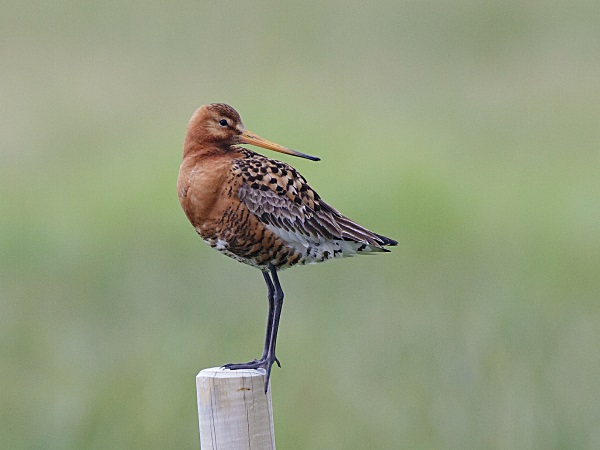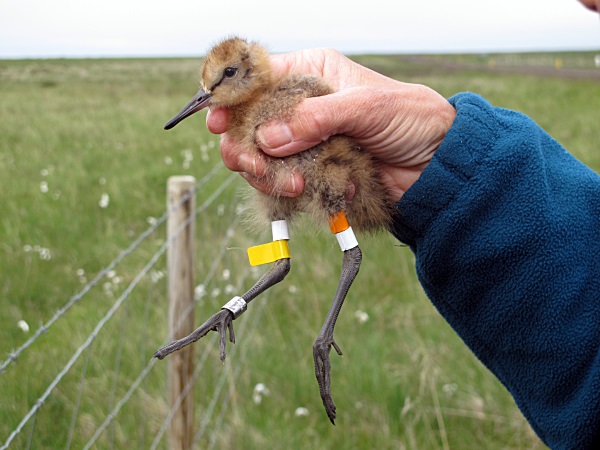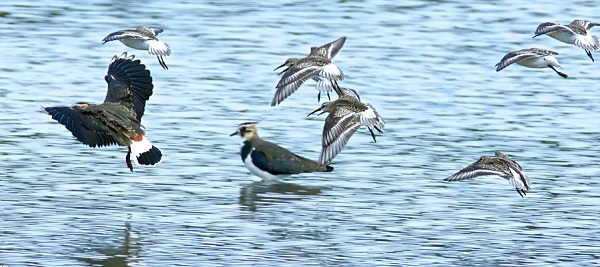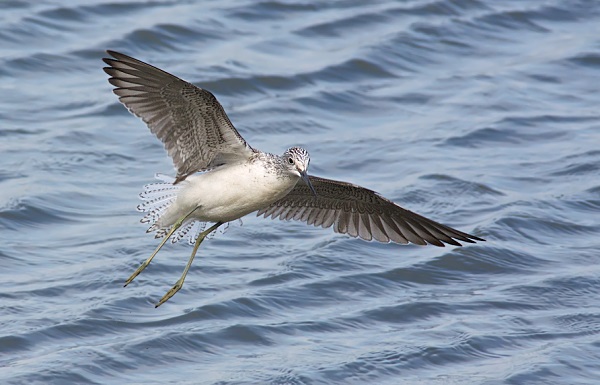Site menu:

November 2013 Newsletter
Chasing Blackwits - Iceland 2013.
October Bird News.
Forthcoming Events.
Latest Newsletter.
Chasing Blackwits - Iceland 2013

see fromthemuddybanksofthedee.com
This story begins on the muddy banks of the Dee and takes us to the
lush meadows and bleak lava fields of Iceland.
It was late May and the grey beige mudflats of the Dee estuary were quiet. The tide was a choppy line of white foam in the distance and sweeping the binoculars from there to the marshes at Heswall there really wasn’t much to see. Where once thousands of Knot and Redshank mingled with hundreds of Oystercatchers and Pintails there were just a few resting Shelduck and a couple of restless Curlew.
There was a late spring flurry of Black-tailed Godwit activity, with many sightings of colour ringed birds, but they have departed too. Several years ago, on a cold and windy afternoon on Thurstaston Beach the the author of this website first introduced me to colour ringed Blackwits and since then I have been hooked on finding and contributing records to this research project. Glancing down the page in my rather battered notebook containing my most recent sightings I wonder how LL-OL, GR-LX and YG-GRflag are doing this breeding season and whether I will see them again on the Dee (for an explanation of the ringing scheme see December 2006 Newsletter).
The springtime disappearance of these birds usually leaves me feeling rather blue. I’m unable to spend time watching and photographing the Blackwits, my favourite shorebirds, until their return in the autumn. However this year I wasn’t at all bothered. This year I was following them north.
Operation Godwit is in its 13th year and I had been invited to join the ringing team in Iceland for an expedition of cannon netting and nest finding to colour ring more adults and chicks. We do this so their migration, population expansion and winter distribution can be better understood and after last year’s spectacular trips to Portugal and Norway it was an invitation that I could not refuse.
Peering through the window of the plane I got my first glimpse of Iceland through a break in the thick blanket of cloud that shrouded the island. Treacherous looking lava fields were covered with a yellowish green moss, making it hard to imagine any birds breeding there. As first impressions go Keflavik Airport and its environs really doesn’t do Iceland justice. The plane touched down into the teeth of an almighty gale. On the drive from the airport the hire car was nearly blown from the road on a couple of occasions and in a draughty youth hostel later that evening I wondered how the Blackwits were coping with the weather that had nearly put paid to my trip before it had begun.
The next morning the weather has eased
a little and I headed north to Reykholer to meet with the rest of the
expedition who had already been in the field for a week. They outlined
the season so far and the plans for the rest of the trip. The Azores
high pressure system that was delivering a burning heatwave across the
UK was causing a wet and cold summer in Iceland. The Blackwits were not
having the best year. However, the plan remained the same, to collect
sightings of previously ringed adults, cannon net some more and find
some chicks to colour mark.
The team was sent out to find Blackwits on territory so we could locate
and ring their chicks and despite the dreary weather I was amazed by
what I found in the lush meadows of northern Iceland.
So. Many. Birds.
The density of the birds was flabbergasting. Not just Blackwits, everywhere I looked I saw breeding waders. Calling from almost every fencepost was either a Whimbrel, a Snipe, a Redshank or a Blackwit. Golden and Ringed Plovers mooched along the roadside, Oystercatchers squabbled in the field margins. On the pools that dotted the landscape Red-necked Phalaropes were nesting and on the bigger ponds and lakes Red-throated Divers were raising young. One fast flowing stream that drained one of those pools held a family of Harlequin Ducks.
I saw a Short-eared Owl being mobbed by a dozen irate Redshank and 50 or so Blackwits went beserk when a Gyr Falcon took one of their number. For any birdwatcher, particularly one interested in shorebirds and seabirds, I cannot recommend a trip to Iceland highly enough. It is now the benchmark by which I will judge all other trips abroad, just a stunning place.
I suppose since that first sighting on
Thurstaston Beach several years previously it had all been building to
this trip. I was getting the chance to see where the birds that take up
so much of my attention on the Dee were breeding. I was also going to
get some of these birds in the hand, birds that I might one day see
again back home.

fromthemuddybanksofthedee.com
During my time in Iceland we set the cannon nets twice and were successful on one occasion, ringing 3 adults. We located dozens of pairs on territory and ringed nearly 80 chicks in two locations. We also collected a plethora of biometric data too. Taking measurements of wings, bills, legs and weight before the birds were released back to their parents.
One afternoon, after a morning spent “chicking”, we arrived back at our base for a bite to eat. The house looked out over a marsh that ran down to a lake where divers, ducks and swans were feeding, beyond the lake a thin strip of seaweed covered rocks led to the fjord. The tide was rising and Blackwits were flying in from the mudflats to roost.
A telescope was trained on the small gathering and the birds counted. Expedition leader Pete shouted that he’d located a colour ringed individual – standing on one leg! All we could see was a yellow ring over a green one on the left leg (YG). I mentioned that my last sighting on the Dee before heading to Iceland was of YG-GRflag and it would be weird if we were looking at it now. Eventually the bird moved and, yes, in a moment that left me speechless the other two rings were a green one over a red flagged one. It was YG-GRflag! I was looking at a bird I had seen just a few weeks earlier! I never thought that would happen!
[I had seen YG-GRflag at Gilroy Nature Park on the 1st May and then again on 8th July at Reykholer. A few weeks after my return from Iceland, on 7th August, I received a message from Richard telling me to head down to Inner Marsh Farm to check out some colour ringed Blackwits. There I saw YG-GRflag again, it was feeding on the scrape in front of the hide!]
Stories like this are brilliant, but
there is a real scientific reason why all of this colour ringing and
Blackwit chasing goes on. The Icelandic population has been expanding
and by studying this we can gain new insights into wader population
dynamics that will be useful in shorebird conservation. We have already
found out so much about survivability, site fidelity and migration
timings. But the real key to what is happening may lie in the winter
distribution of these birds and more study is required. This is an area
that we can all help to explore. We are very lucky on the Dee to have a
large wintering population of Icelandic Black-tailed Godwits and a
fabulous network of sites that they use. We can all look for and report
sightings of these colourfully marked birds and contribute to their
conservation as we birdwatch.

fromthemuddybanksofthedee.com
If you see a colour ringed Blackwit
make a note of the colour combination (left leg first reading top ring
then bottom ring, followed by the right leg, again reading top down.)
and send the sighting to Richard (
![]() )who co-ordinates and submits the records of
Blackwits on the Dee.
)who co-ordinates and submits the records of
Blackwits on the Dee.
There are more chapters in the Blackwit story waiting to be written and we can all be authors – every sighting counts!
Matt Thomas www.fromthemuddybanksofthedee.com
Top of PageOctober Bird News

Although there wasn't the huge numbers of birds on 'Visible Migration' as sometimes seen there was a good passage of Redwings with well over 1,000 over north Wirral on the 11th and about 1,000 heading south along the marsh at Gayton on the 20th. A Blyth's Reed Warbler at Hoylake and a Yellow-browed Warbler and Turtle Dove at Leasowe Lighthouse was part of this general return passage.
The good Curlew Sandpiper passage continued with max seven on three dates at Inner Marsh Farm, with just a few at Hoylake - total number of records was 59 to add to the graphs shown last month. There was also a Pectoral Sandpiper at Inner Marsh Farm/Burton Mere Wetlands, present until the 5th. Greenshanks were coming through all month with a max count of 23 at Parkgate and eight at Connah's Quay early in the month. On the estuary itself there were good counts of 1,200 Black-tailed Godwits at Thurstaston on the 18th (c20 colour-ringed) and 800 Sanderling at Hoylake on the 21st.

Pink-footed geese numbers increased with 'several hundred' at Burton Mere Wetlands and 300 on Parkgate Marsh. Brent Geese numbers were up to 124 at Hilbre by the end of the month. Two Great White Egrets flew into the estuary on the 30th.
There were strong winds on several days and Leach's Petrels were recorded on the 9th (max 3 at Hilbre) and on the 29th (2 at New Brighton). The strong winds were probably also resposible for a late Sandwich Tern at West Kirby on the 28th, this was colour-ringed in the Netherlands on May 28th and was seen in Newport, South Wales, on Oct 7th and 25th, before being blown north.

Richard Smith.
What to expect in November
There has been very little sign of any Short-eared Owls yet this winter, but even in a poor year we would expect a few this month. We would also hope for a male Hen Harrier or two, and hopefully at least four ring-tails. We are likely to see at least one Great White Egret on the marshes and a Spoonbill is always a possibility.
Last winter was particularly good for Knot and Sanderling and we should have large numbers this month with Point of Ayr, West Kirby and Hoylake the best places to see these at their high tide roosts. The pontoon on New Brighton Marine Lake, and the nearby sea defences, have become an excellent place to see Purple Sandpipers in recent years and we would expect up to 20 this month.
As somebody who grew up in a largely gooseless Dee Estuary one of the joys of recent years has been the return of Pink-footed Geese to the marshes and we would expect well over 1,000 of these this month. They can be a hard to see as they are often on the outer edge of the marsh off Parkgate but can be seen flying and sometimes they land close to the prom, also they often come into Burton Mere Wetlands. Brent Geese are also a species that has been rapidly increasing in recent years and these can be seen feeding around Hilbre Island at low tide. At high tide West Kirby shore is a good place as they are often around Little Eye or just off the marsh.
Snow Buntings often peak in November and and are usually fairly easy to see if they stick around, although only in very small numbers. The beach at Point of Ayr is probably the best site to see them, otherwise try Gronant, Hilbre, West Kirby or Hoylake. There is often a large flock of Twite around the Flint Castle area, perhaps as many as 100 or so, occasionally small numbers are seen on the English side of the estuary or along north Wirral.
Top of Page
Forthcoming Events
November Highest Spring Tides (Liverpool)
Also
see Tides
page.
4th November, 11.19hrs (GMT), 9.7m.
5th November, 11.51hrs (GMT), 9.8m.
6th November, 12.35hrs (GMT), 9.7m.
Forthcoming Events
Organised by the Wirral
Ranger Service , Flintshire Countryside Service and/or the
RSPB:
All these events and walks have bird interest, even those not
advertised specifically for birdwatching. No need to book for these
events unless specified - please check below.
Also see 2013 Events Diary.
Cheshire and Wirral Ornithological Society 25th Anniversary Celebration 9th Nov 2013 CAWOS is pleased to announce that it will be holding a half day event to celebrate the 25th Anniversary of the Society on Saturday 9th November 2013 from 11.00am to 4.00pm.
Please come and join us for this, our Special Celebratory Day for members/ non members and friends, old and new at Leahurst Campus, School of Veterinary Science, Neston, CH64 7TE. The day will include a programme of talks about Cheshire's birds with associated quizzes and raffle. Lunch and refreshments included all for only £5.00pp.
For further information contact Clive Richards (tel. 01625 524527) or Ted Lock (tel. 01625 540466).
Application forms can be downloaded by clicking on this link.
Friday 22nd November, 10 am - 4 pm, RSPB New Brighton Wader Watch.
The marine lake at New Brighton can be the best place in the area to see turnstones and purple sandpipers, two of our most elusive winter visitors. Head for the Wirral Rangers' mobile information unit in the car park between the marine lake and Fort Perch Rock, where we'll be set up with telescopes and binoculars to help you get close views of these enigmatic birds.
Ample parking and a variety of food and drink available nearby.
High tide is at 1.30 pm.
Saturday 23rd and Sunday 24th November, RSPB Skydancers on the Dee.
12 noon until dusk. Meet at the "Donkey Stand" opposite Nicholls Ice-cream shop on The Parade (B5135), Parkgate, Cheshire.
Most people have never seen a hen harrier, but once seen it is rarely forgotten. For the second year, we are pleased to bring you a series of events to showcase these enigmatic birds of prey which use the marshes of the Dee Estuary as their home for the winter months.
The name "Skydancer" comes from the aerobatic displays that the male birds perform in their courtship ritual on the moors in the spring. Sadly, this is becoming an increasingly rare sight; they are close to becoming extinct as a breeding species in England, with not a single successful nest this year.
This could be the last chance to see Skydancers on the Dee, so come along to Parkgate to find out more about the hen harrier story and what you can do to help save them before it's too late! Look for the RSPB marquee along the main promenade at Parkgate, where friendly staff and volunteers will be on hand with telescopes and binoculars to show you these beautiful, agile birds hunting over the marsh, and coming in to roost there at dusk. Plenty of family activities and other RSPB information will be available.
For more information on the RSPB's Skydancer project, visit
http://www.rspb.org.uk/skydancer/
Saturday 30th November 12:00 noon – 3:00pm
Take Tea on Hilbre with the RSPB
Walk across the sands to Hilbre Island where the RSPB will be serving tea and biscuits during the above date and time. They will be on hand to show you the island’s unique wildlife and will tell you about the work that the RSPB are doing at their fantastic reserve at Burton Mere Wetlands. There is no need to book, just turn up. Suitable clothing and footwear are essential for the walk out and please note – this is not a guided walk. Remember to bring money for the tea!
For further information, please telephone (0151) 648 4371.
Wednesday 4th, Thursday 5th, Friday 6th December, RSPB Parkgate High Tide Watch.
Parkgate Marsh is one of the best wetland habitats in the northwest, and when it is flooded by an incoming Spring high tide, the wildlife which lives here is pushed closer, potentially delivering an awe-inspiring spectacle. Join us at the Donkey Stand on The Parade, where we'll be set up with our marquee and telescopes hoping for the right weather conditions to really push the tide in.
You can expect great views of the large numbers of wintering wildfowl and waders shifting around to avoid the rising water, whilst the small mammals living on the marsh are flushed from cover, offering a feeding frenzy for the kestrels, harriers and short-eared owls.
It is recommended to arrive at least one hour before high tide.
High tide details: Wednesday 4 December, 9.9 m (32.4 ft) at 11.36 am; Thursday 5 December, 9.9 m (32.5 ft) at 12.24 pm; Friday 6 December, 9.8 m (32.1 ft) at 1.12 pm.
Saturday 7th December - 12:00noon start, high tide 1345hrs.
High Tide Birdwatch at Hoylake:
Join the Coastal Rangers, the Dee Estuary Voluntary Wardens and the RSPB to see the large numbers of wading birds on Hoylake beach. With a rising tide, we should see the birds at close quarters as they roost and feed. Beginners welcome. Dress warmly and bring binoculars if you have them.
Meet on the promenade at King's Gap, Hoylake.
For further information, contact the Coastal Rangers on 0151 648 4371.
Saturday 14th December 12:00 noon – 2:30pm
Take Tea on Hilbre with the RSPB
Walk across the sands to Hilbre Island where the RSPB will be serving tea and biscuits during the above date and time. They will be on hand to show you the island’s unique wildlife and will tell you about the work that the RSPB are doing at their fantastic reserve at Burton Mere Wetlands. There is no need to book, just turn up. Suitable clothing and footwear are essential for the walk out and please note – this is not a guided walk. Remember to bring money for the tea!
For further information, please telephone (0151) 648 4371.